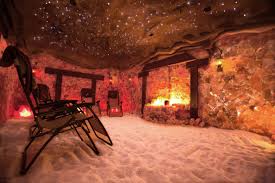Yesterday I tried Halotherapy for the first time. For those not familiar with the term, Halotherapy is salt therapy. The name is derived from the Greek word "Halo", meaning salt. It’s a treatment that has gained a huge following and is among one of the trendiest holistic therapies of the moment. After hearing so much about it, I decided to try it for myself. The idea might seem modern in theory but it is actually ancient in practice going back centuries among different cultures as a way to treat respiratory and other ailments.
There are different types of salt treatments from bathing in sea salt to using salt scrubs on your skin, to breathing in salt infused air. You may have seen those rock salt lamps made of Himalayan pink salt all over the place lately. People put them in their homes, on their desks at the office, just about anywhere. The light from bulb inside the lamps is said to release negative ions into the air when the salt heated, which acts as an air purifier. Halotherapy on the other hand involves breathing in salt infused air, which is like the lamp idea but on a bigger scale because salt particles are actually pumped into the room via air vents. This is what I tried, while sitting in a “cave” made of pink Himalayan salt.
Salt caves are all the rage now and many have opened in places like yoga schools, 5 star luxury hotels, and spas of all kinds around the world. The cave is actually a room with walls made out of chunks of pure pink Himalayan salt. Pink Himalayan salt is said to contain over 84 minerals and trace elements. The reason why it is so popular is because it is considered the most pristine salt in the world, supposedly because it sat protected under layers of lava in the Himalayan mountains for thousands and thousands of years and therefore not exposed to toxins and pollution. If you look online you’ll find a wealth of information and articles with claims of salt therapy aiding in everything from balancing electrolytes to regulating water content in our cells, to alleviating symptoms of acid reflux and muscle cramping. Advocates of Halotherapy also say that breathing in the salt air provides relief from allergies, sinus issues, upper respiratory problems, lyme disease and a variety of skin conditions. Other health conditions also listed as benefiting from salt therapy are arthritis and digestive disorders. While these claims have not been scientifically/medically proven, testimonials abound online from those who swear that Halotherapy has made a significant difference in their ability to cope with their symptoms. In fact, there were a few people at the spa where I attended my session who extolled the virtues of the salt cave and the positive impact the therapy has had on their quality of life.
The floors of the cave are covered in salt pebbles that make you feel like you are at the beach, only the “sand” is pebbles of pink salt so it’s a bit prickly on the feet. You can wear socks if you like, or not, it’s up to you. But you must remove your shoes. Other than that, you can wear whatever comfortable clothing you like to the session. There are usually others in the room with you. There were about 10 people in my session. We were provided with blankets because the room gets a bit chilly though I found it to be comfortable -- and I’m a big baby when it comes to cold temperatures!
So how does it work? You are asked to turn off your cell phone and to not talk during the session. You are free to meditate or nap, if you like. You sit in silence in zero gravity reclining chairs, for 45 minutes. During that time salt particles are pumped into the air and calming Zen music is played through speakers. The ceiling in my salt cave was made of twinkling led lights that resembled stars, very pretty! Behind the wall of salt and interspersed throughout the cave are lights which emit a warm orange glow. There was a salt “fireplace” in our cave which was illuminated, as well as a large illuminated salt boulder. The heat from the lights acts like your little home or office salt lamp to purify the air, adding to the benefits of the salt particles being pumped in via the ducts in the ceiling.
The verdict? I definitely felt calmer when I left, and I slept really well last night. Whether that was from the salt or from the meditation and Zen music in the cave, I can’t tell. I’ll have to go back for a few more sessions before I can say for sure that I see the benefit in the therapy. I will say this, however. I had been dealing with sinus issues the last few weeks and last night my head and nose were clear, and still are this morning. Also, when I put my side-zip boots on yesterday morning before I went to the session they were a bit snug. When I put them on again after the session they zipped right up and were actually loose around the top of my calf. Was it the salt? Maybe. Again, more visits are needed to determine if it is indeed the cave doing its magic.
If nothing else, this therapy is a great way to relax and calm the mind. The 45 minutes in silent meditation is in and of itself a huge benefit for anyone. Of course, if you have a medical condition you should check with your doctor before beginning any type of treatment or therapy.
Here is a photo of what a salt cave looks like. This is not the one I went to, but rather a photo from the internet to give you an idea of what you’d see. They can look different depending on where you go and what type of facility it is (ie spa, yoga school, etc.)
Wishing you all a peaceful day!









